Tyler Sehn's Blog
June 30, 2025
Whatever Man
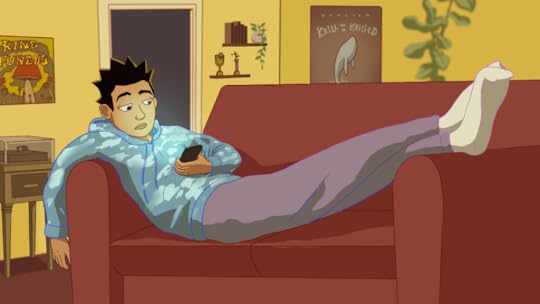
A disenfranchised office worker wakes up each morning with a different absurd superpower, taking him on surreal adventures full of unexpected challenges.
A concept that came to me years ago and has taken a while to percolate. This story is now available on Substack in tasty, bite-sized morsels.
Something to read instead of scrolling Instagram/TikTok before bed. It’s all good if you only read one story because your baby is crying or if you read four because they fell asleep.
The final form of Whatever Man is an animated TV series, so read and share and eventually tune (toon) in.
June 3, 2025
The Maze House
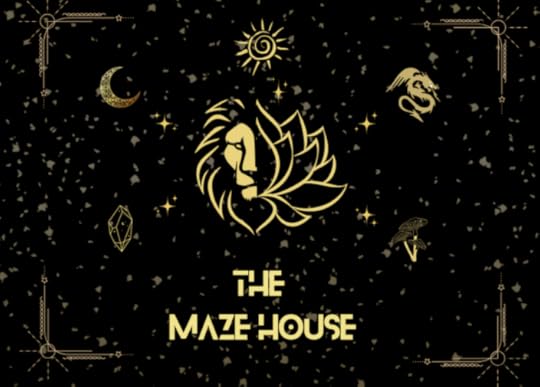
Inspiration has momentum even when it’s unclear where it’s going. For example, this random poem/thought came my way years before I started writing The Maze House, which is now well underway to becoming a novel.
The initial inspiration went something like this:
The People stared at the Labyrinth.
“Work with me People,” said the Labyrinth.
To which the People scrunched their brows in confusion.
“I am right here,” said the Labyrinth. Yet the people remained skeptical.
“Questions are steps toward the center,” said the Labyrinth.
And the People bit their tongue.
“If you have a change of heart, you know where to find me,” said the Labyrinth.
The People blinked as the Labyrinth disappeared.
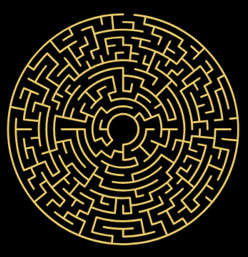
I’m doing things a little different on this go-round and releasing chapters every week on Substack. I’m enjoying the community component of the platform as well as the consistent engagement on my part, rather than waiting to share until fully completed. A few years ago I wouldn’t have tried this, but a decade of being an author has allowed me the experience to bend (and sometimes break) the rules. The Maze House will be a published novel eventually. For now, here is a description:
The apocalypse went pretty well, as far as such things go.
Humanity has shifted into three distinct Veins. Some use magic and live in floating cities, others commune with nature and Ancestor spirits, and some are merging with technology.
Things are getting weird, but maybe that’s a good thing.
The Maze House is the only place where the Veins converge. A rare few gain access and none have ever returned.
The living myth of this story is the unlocking of a door, an opportunity to step fully into the unknown.
Relax, it’ll make sense when you get here.
January 2, 2025
Substack
I’ve been having fun with a whole different kind of writing lately (some sort of fusion of prose, poetry, surrealism, short story) and these pieces will be available on Substack.
Follow the link and see if this catches your fancy.
November 6, 2023
Change, Completion & the Creative Process
Starting a project is one thing, but knowing when it’s finished is something completely different. How to tell when creativity is expressed in its fullness? How to recognize the difference between resolution and obsessive tinkering?

This is an ongoing scenario I’ve been processing since the tail-end of the pandemic, when the idea for a story arrived with force and vision, seemingly straightforward in its expression, but has since continued to evolve, going in directions I never expected at the start. The original idea unfolding into a story, which then developed into a novel. The two novels I wrote during the pandemic (The Pale Queen and Witch 6) also proceeded in this manner, seemingly imbued with their own momentum.
But this new novel is an expansion of style for me, the writing differing from that of my previous novels. A different setting as well—our own world (albeit on an altered timeline).
First-person narration and real world references had the ideas flowing so much so that the words seemed to write themselves. Even the images of a cover appeared in my mind’s eye, ready to be sketched out. And in a blink it was all done; ready for beta readers. The next step was to integrate their notes and get it cleaned up for a content editor, but at this point the story shifted before my eyes. Layers emerged. Angles adding to the structure. And then it was done, again.
Except, now it didn’t feel complete.

Something was missing. An unknown element. A crucial ingredient for proper flavour. So I set the story aside, gave it some space to breathe. Several months later and another round of edits—more layers, more angles. Still not quite right. Set it aside again.
Shifting my focus to other projects (quite different in style and format) I put this story out of mind. And as is so often the case—BAM!—fresh insights and copious notes about the original project. Back to the story, since it seemingly wasn’t finished with me yet. There was more to tell and I was genuinely surprised at how it all seemed to fit together, despite (or perhaps because of) radical changes to the storyline. Now it feels ready.
That invisible absence disappearing.
So I set it aside once more, just to make sure. Sent it out to a beta reader (why not?). Last step is a brief edit to get this new storyline straight in my own mind. Then the manuscript is off to an editor. Receive their feedback and make any necessary changes. Will it be ready then? Complete? Guess we’ll find out.
This shapeshifter of a novel has been a joy to work on; endlessly surprising. Almost like it was testing me, gauging my sincerity as well as my openness to change. Its form gradually coming into sight as my perspective became more multifaceted.
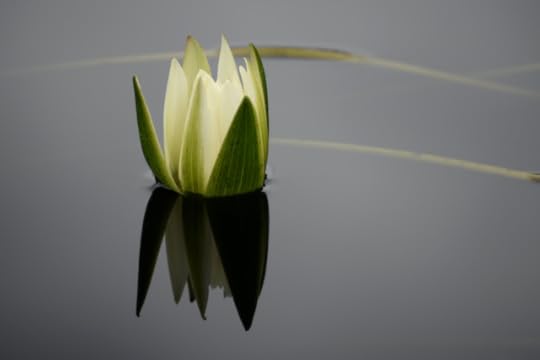
So how to know when a creative project is finished? When it tells you that it is. When it shows you the fullness of its reflection.
October 24, 2021
Sagas: Completed & Ongoing
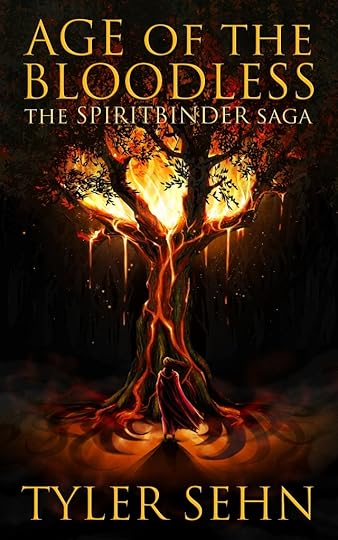
Age of the Bloodless, the third, and final, aspect of The Spiritbinder Saga, has been published. This book weaves together the many threads set in motion in Daughter of Shadow and Gods of Rua. World-spanning schemes and overarching themes come together for an ultimate showdown. The ambitions of warriors and priests, bandits and crime-lords, gods and creatures culminate in an epoch changing event.
But can three books qualify as a saga? The definition of saga states: a long story of heroic achievement; a long, involved story, account, or series of incidents.
406, 894 wordsDozens of charactersHeroic developmentTrials and tribulations galoreLayers on layers as the actions of characters influence each other, knowingly and unknowinglyIt’s quite the ride. There’s plenty of space for prequels, sequels, side stories, and spinoffs as well. This trilogy was built around Melea, a figure who appeared in my dreams and started it all. Her progression as a character has gone full-circle and so, for now, The Spiritbinder Saga must rest.
Reflecting on the trilogy got me thinking about my own life during this timespan. Quite the ride, as well.
[cue the montage of flashback scenes]
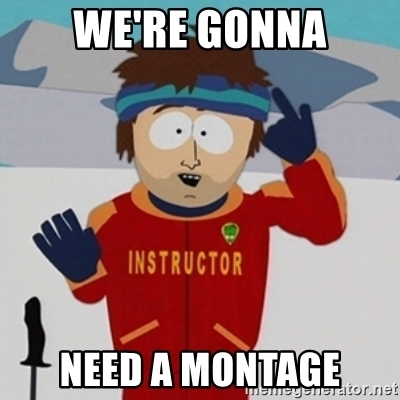
Several cross-country moves (Canada is large), a debilitating injury to a loved one and her recovery, travelling to Europe (twice), journeying north of the Arctic Circle, a house fire (she gone), coaching championship high school basketball teams, a house purchase (and the ongoing renovations), a car rolled over in the ditch, paddling rivers & hiking trails, substantial professional training, personal development (both minor and monumental), partying in Toronto for the Raptors first championship, writing & publishing two separate novels, a global pandemic, marriage, many poems, and much love (countless moments with friends & family).
[End montage]
A few less swords than The Spiritbinder Saga (and more fine dining!), which is probably for the best, all things considered. The process of writing this trilogy has taught me a lot and I look forward to the next phase along the path.
April 22, 2021
Evolution of The Hero’s Journey
If you read books, watch movies or television, then you have encountered The Hero’s Journey in modern storytelling.
The concept of the hero’s journey was introduced in a book called The Hero With A Thousand Faces, published in 1949 by American professor, Joseph Campbell. The book argued that all ancient mythology tells one core story: the human psyche’s development from child to adult, and ultimately to fully realized individual. CBC Ideas
This story structure became immortalized when George Lucas embedded it into Star Wars. The success of Star Wars speaks to the cultural resonance that the Hero’s Journey is capable of. Hollywood, in the pursuit of box office profit has fully capitalized on this mythological underpinning, churning out iterations of the Hero’s Journey in varying levels of quality.
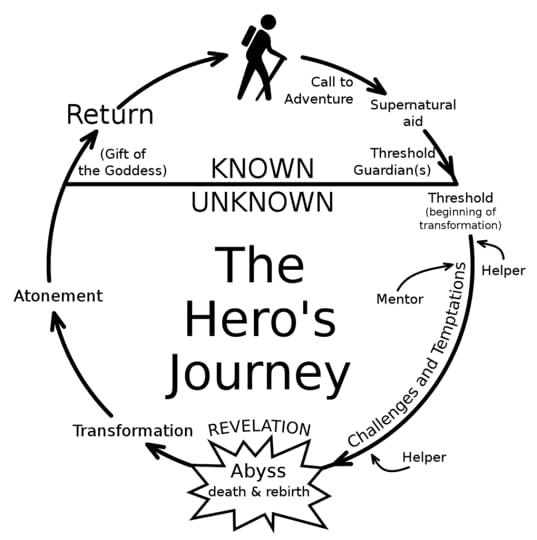
https://en.wikipedia.org/wiki/Hero%27s_journey#/media/File:Heroesjourney.svg
Storytelling unlocked! The code has been cracked! It seemed so at one point, or at least was presented that way by Hollywood and publishing gatekeepers.
I’ve read several of Campbell’s books, including The Hero With a Thousand Faces, and thought he made a lot of good points. I’ve watched the 1988 Bill Moyers series “Joseph Campbell and the Power of Myth” and found it inspiring. I enjoy Star Wars, The Lion King, and The Matrix—all which are commonly portrayed as prime examples of Campbell’s theory. I read and write fantasy & science fiction novels, which are thoroughly steeped in the Hero’s Journey. And yet…I have issues when encountering anything presented as a monomyth that encapsulates all stories. Doesn’t feel right. A little too ambitious.
This description, in Campbell’s own words, provides more nuance than is usually offered by secondary sources regarding the Hero’s Journey:
The individual, through prolonged psychological disciplines, gives up completely all attachment to his personal limitations, idiosyncrasies, hopes and fears, no longer resists the self-annihilation that is prerequisite to rebirth in the realization of truth, and so becomes ripe, at last, for the great at-one-ment. His personal ambitions being totally dissolved, he no longer tries to live but willingly relaxes to whatever may come to pass in him; he becomes, that is to say, an anonymity. Narrative First
Now that’s the juice! An unassailable psycho-spiritual storytelling phenomenon, right? Well…
A Few Critiques
Everything depends on whether The One in The Matrix is going to be successful or not, the hero is going to save the world or not,” and “That’s, I think, the political danger. If everyone is thinking that they’re the hero, then there’s no possibility of thinking with compassion from the point of view of other people who are experiencing completely different stories as you are. CBC Ideas
Hmm, this comment does imply an unintended long-term consequence of ramming a monomyth down culture’s throat. If everyone believes they are a hero then that means anything in opposition to their own self must be evil, or at minimum, wrong. Draw your own conclusions about this proposition when considering the current socio-political landscape of the world.
Despite the pretense that these are ancient stories conveying what Joseph Campbell would call ‘boons from the transcendent deep,’ these are basically stories that are told by those in power in order to convince others that they should have power. CBC Ideas
Doesn’t sound as numinous and sacred when framed that way. The Hero’s Journey tends to involve an individual overcoming outer obstacles, learning how to survive, defeating rivals, being reborn as more than human thus receiving a higher social status; all concepts that can easily be subsumed by an economic ideology perpetuating the belief that a person should “pull themselves up by their own bootstraps” by sacrificing, risk taking, and hard work. Has this occurred? Maybe, maybe not, but it’s not so different when the psycho-spiritual aspect is deemphasized.
There is a sickness running through the world, a sickness that attempts to twist every instance of narrative fiction through the siphon of errors that is the “Hero’s Journey” story structure paradigm. Narrative First
It seems to me that this statement is referring to the role that existing systems take in directing what gets made. The storytelling process becomes a tool to reinforce the structural system, whatever it may be. Differences are cast out or realigned, if they are seen at all. The system wants to preserve itself, to continue its growth, so it taps into a known and trusted resource.
It might be assumed that the Hero’s Journey is the sole property of males and this is untrue, although it has historically been a male-dominated realm. Females can be, and are, heroes able follow this process, yet there seems to be a need to improve inclusivity.
…introduce an archetypal structure that expands the work of Joseph Campbell to include a feminine archetype. Maybe it will create more meaningful roles for women. That would be good. I would also hope it will create stories about men who also want to follow their spiritual, sexual or creative awakening, otherwise known as their feminine side. Kim Hudson
Too narrow of a paradigm is potentially as damaging to the males included within the monomyth as it is to the excluded females as it can lead to imbalance, emphasizing hyper-masculinity. Is a male supposed to always be in “hero mode” ? What happens when a person is exclusively expected to be rugged, strong, brave and challenging boundaries? Doesn’t seem sustainable. Not all that fun either.
Some Alternatives
Two of the most viable, and interesting, storytelling methods that I have come across are The Virgin’s Promise and Dramatica.
Dramatica is a complex, comprehensive structure that I can only touch on here.
Stories are about solving problems. Sometimes, solving those problems require the centerpiece of a story, the Main Character, to undergo a major transformation in how they see the world. Sometimes they don’t. There is nothing inherently better about a story where the Main Character transforms. Narrative First
The whole spiritual transformation aspect of Campbell’s theory are not at play within Dramatica, instead preferring a more objective approach.
The Main Character comes to a story with some emotional baggage. The Influence Character enters and by virtue of her presence, brings the Main Character’s baggage to the surface. She “impacts” him. One way or another, the two argue over the proper way to solve the problems in the story until at the end the Main Character has to come to a decision: Either keep doing things the way he always has, or change and adopt the Influence Character’s way of seeing things. Narrative First
Many examples come to mind, particularly the tried and true features produced by Pixar. More give and take than the classic Hero’s Journey. Development as more of an interaction rather than individuality overcoming outside forces.
The Virgin’s Promise is closer to a mirror image of Campbell’s theory:
…has two meanings and in a nutshell…The first meaning is the community’s belief that the Virgin has agreed to live up to their expectations. She has made a promise to them. The second speaks to the Virgin’s unproven potential that lies dormant within her, longing to come to life. The Virgin begins by conforming to the wishes of others and eventually learns to hear her inner voice and bring it to life. It is the journey to creative, spiritual and sexual awakening. Writers Store
And
The Hero leaves the village to ward off danger before it arrives and creates havoc in a foreign land. The antagonist is the personification of this foreign land and is basically evil and rightly destroyed. The Virgin lives in a Kingdom that is in need of change. The kingdom is stagnating and needs to allow more individual freedom. Growth of the Virgin forces growth of the Kingdom. Writers Store
I love this take. What happens after the dragon has been slain? Or when the enemy is not an overt other? What if the problems are close to home? What if the problems are built into home itself?
The Virgin is learning to be self-fulfilling. Her highest purpose is to overcome her Father Complex and make choices in her life based on her own values. She must follow her passion and know joy and love. She is about awakening her sexuality, spirituality and creativity and making her dreams come true. Writers Store
This is a facet of human existence of which the Hero’s Journey is ill equipped to portray. This is no fault of the Hero’s Journey—it has a distinct, useful core of themes built for certain circumstances. Hudson’s theory provides clarification for another way of being in the world.
The Virgin journey includes a friend while the Hero is aided by allies. The Virgin’s friend sees her potential and supports her in her quest to be true to herself out of love rather than personal gain. The Hero meets allies along the way who share a common goal. They don’t have to like each other; they simply have to share a common purpose. Writers Store
Hudson’s theory is compatible for males and females, which I have discovered in my own writing. My novels The Pale Queen and Witch 6 both feature male protagonists following their version of the Virgin’s Promise.
Seren, in The Pale Queen, is a magic wielding poet-warrior carrying a devastating weapon who at first glance checks many of the Hero’s Journey boxes, but the story begins with Seren at the height of his powers. He has already overcome obstacles, sacrificed, shown bravery and yet…his lover has left him and he faces a threat that cannot be punched or slashed.
Mavrik, in Witch 6, is a formidable witch with voodoo-like abilities as well as a prince of sorts due to his heritage and yet…he is unable to receive a higher social status and is facing a force beyond the scope of a single person’s power.
Both characters must discover how to live in a world where strictly being a hero is incapable of solving the problem. They must learn how to expand their awareness to include that of other people, their communities, and the wider world. This process is more aligned with the Virgin’s Promise even though such characters and settings typically adopt the Hero’s Journey.
Our world and the stories used to express our understanding of our roles within it are changing. People believe what they see, leading me to be of the opinion that narratives facilitating this changing understanding need to be integrated within cultural consciousness.
Let me know what you think! What are some other examples? What are avenues for modern storytelling?
February 28, 2021
The Pale Queen – Preorder
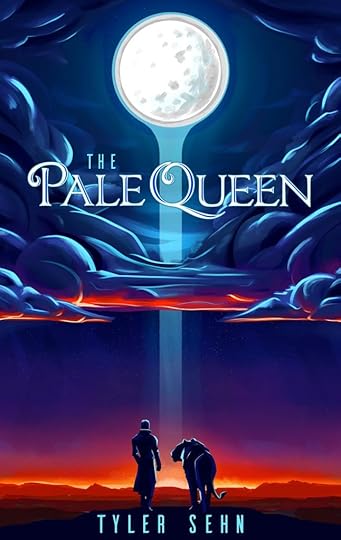
The Pale Queen is available for preorder as an ebook on Apple Books and Kobo and will be available on Amazon (ebook & print) on March 13, 2021! If you use Apple Books or Kobo please consider making a preorder as it helps with their ranking systems.
Synopsis:
A story can be freedom. A story can be prison.
In service to the mysterious Pale Queen, a poet-warrior navigates a world of magic, carrying a weapon created to kill gods.
Seren searches for his lost lover, striving to find her before the coming of the Never-Was. He writes in a secret notebook about encounters with friend and foe, hoping to make sense of these entangling threads. With his lion companion at his side, Seren seeks truth at all costs.
In a world where the lives of humans and gods are bonded, a single quest can encompass all.

The Pale Queen is a non-traditional way of conveying a fantasy story and I think of it as a living myth. It is probably more suitable for fans of Studio Ghibli (Miyazaki) and Life of Pi (Martel) rather than Lord of the Rings (Tolkien) or Harry Potter (Rowling). Although, there is bound to be some overlap.
The story is on the shorter side yet is action packed and full of gods, beasts and magic. The style is flowing and poetic, with the goal of creating a unique experience for the reader.
Feel free to contact me if you have any comments or questions!
February 19, 2021
The Stories We Live
We are the stories that we tell ourselves.
So, who are we when those stories are changing? And we’ve all gotten acquainted with change in 2020, whether we liked it or not. Structures and systems portrayed as immovable have been shaken, and some have collapsed. Those still standing now bear visible cracks. Beliefs, individual and collective, have been rattled as well, subjected to the same shifting as their more tangible expressions. Like a hermit crab that has outgrown its shell, how do we navigate our way into a better fit?

In an article for Emergence Magazine, author and activist, Alexis Wright, calls this process an “inward migration.”
“…most often a solitary journey, a turning away from the bombarding speed of reality hitting your very sense of being and destroying your soul…it’s where we go to slowly pick things apart, to reimagine our world in new ways, and sometimes we come out on the other side with a map of how to make some sense of our world.”
A story is a lie to get to truth.

Problems arise when we become attached to the lie, taking the story as reality and setting it atop a psychological house of cards. We know, intuitively, that any change may cause a breakdown, so even the briefest of challenges initiates a survival reflex. This biological programming is often rationalized to be our individual bedrock, yet how can it be? Humanity could never have persisted through any significant change with this steadfast rigidity as a guiding principle.
A point elucidated by Wright: “When you move into the realm of your own sovereignty of mind by shielding yourself from the kinds of interferences that rob you of the ability to think straight, that sap your spirit, or block you from seeing and making your own judgment, then you are able to govern your own spirit and imagination.”
Stories shape underlying structures by tapping into the imagination, setting the stage for our awareness.
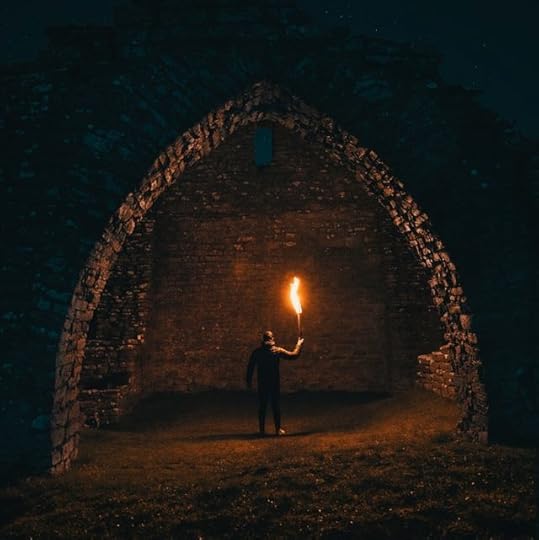
All human creations ultimately emerge from imagination in the form of thoughts, ideas and inspiration. These immaterial tools become questions, actions and objects. Reality influences how we live and is in turn co-created by how we choose to live. Our current stories seem unworthy of fulfilling this collaborative process; more akin to inertia than inspiration. New stories are required so that we may allow ourselves to see differently, because a person believes what they see.
As Wright says: “This is where we fashion, and refashion, and imagine the stories we want told, where we catch the essence of a story before it drifts away, or before it is overrun by the power of those other stories, created by the score in this country, to distract our thinking.”
Old stories told in a new way. Ancient style in a modern package.
Our world is a series of cyclical layers supported by interconnected forces and interdependent beings. Objects in motion within cyclical systems always return, eventually. It seems as though we are nearing a return as we enter a new era of human understanding.
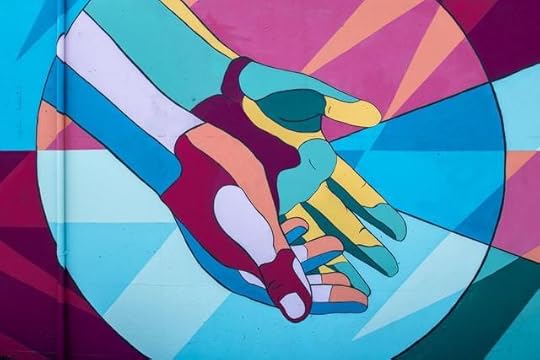
Alexis Wright goes on to say: “We return to talk with the spirits about how the deep feelings of culture can be thought through, cared about, and compared with our knowledge of the world. It is where we examine truth, and it is through our soul-searching that art and beauty can grow, regenerate, deepen the connections…”
A challenge and a call to action. Personal responsibility with collective consequences. The Emperor has no clothes, we can all see that now. How much longer can we look away?
Wright asserts a need for, “…those who will search ceaselessly through the backwaters of their minds, hearts and souls to find ways to powerfully articulate the new stories, the new sagas, the new imagination, and the new epics of the world, inspired by their doubt, fear, love, longing and wondering.”
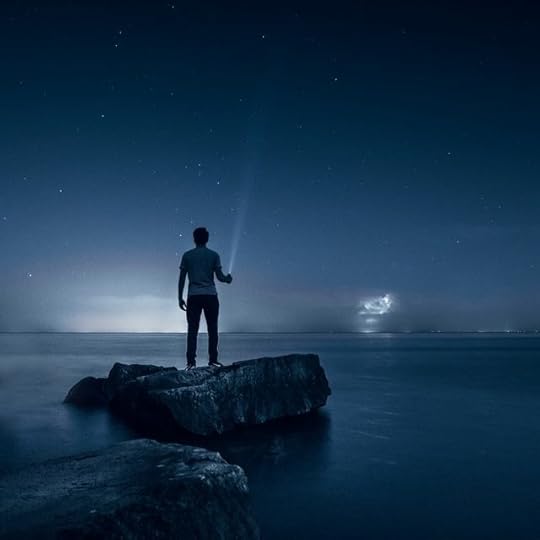
In my experience, beauty has become a useful perspective in pursuing an aim similar to Wright’s. Beauty as a synthesis of so many contradictions. Beauty as a momentary unifier of paradox. Beauty as a compass for truth.
As a writer, sometimes one encounters a story that seems to arrive like a bolt of lightning out of an empty sky, a story seemingly vivified by its own energy and ready to be expressed. An example of this for me is, The Pale Queen, a fantasy story that I think of as a living myth. The Pale Queen surprised me in its difference from previous fantasy that I have written, as well as its deviation from a fantasy-structure that I typically enjoy reading. I found the writing of it to be refreshing and hope that readers will share a similar experience.
The Pale Queen will be released March 13, 2021. More details to come.
December 3, 2020
Beauty is an Option
Some emotions transformed into thoughts, transcribed into words, digitized and shared, from a prairie town in Alberta, Canada.
When the actions of our elected representatives are confusing, disappointing and incensing, it’s important to remember that our collective choices put them in these positions of influence. The system works bottom-up as much as top-down. The choices we make, or don’t make, as individuals create our communities, society, and world.
Those in power (whichever party or colour) will attempt to control the narratives of daily life because this is what we told them to do. This is their role. But it is our role as individuals, friends, family, and citizens to choose the beautiful, because no leader can tell you what to love. And if they tell you what to hate, then they aren’t a leader.
Discover the beauty in your life and share it with those you care for. Beauty is the truth in the story of your life and it’s on each one of us to find the courage to accept this choice.
[image error]
sometimes when looking into that Alberta sky
it’s hard to tell
if I’m going the wrong way
then why does this road lead to home?
where I’m living as best as I can
in love
to be so fortunate
born with a fighting chance
the way I see it
Why not?
have faith in the wind’s freezing kiss
beneath a sky as big as the question
deep as the space in my chest
enough to fall into
alone
together with everyone else
looking into this endless blue
July 9, 2020
Making Sense of the World Through Fantasy & Sci-Fi
We live in overwhelming times, although I suppose people always have. Tiny bodies caught in a massive gravitational pull. Cause and effect, strangeness, beauty and choice all wrapped up together. Each individual seemingly at the centre, capable of being a hero or villain. Perhaps this is why fantasy and sci-fi have risen to the forefront of popular culture; the scale and scope of these living legends resonating in our consciousness.
We sense the vastness, the grand scope, the great threat and dreaded task. We seek direction and inspiration. For humanity, since the beginning, it appears that we have looked to story to provide meaning, to help make sense of our own role in this complex existence. A story has pattern and rhythm, rise and fall, beginning and conclusion; a world contained. A vehicle offering an objective view, a way to safely make connection, as well as providing opportunity for reflection.
Books have the particularly subtle quality of encouraging the reader to place themselves inside the story; an invisible sort of give and take. Individual perspective works with the words to shape a unique experience. This is magic. Technology not fully understood, even today. True whether you live in the Shire or Mordor, Smallville or Gotham.
Some readers prefer a more optimistic outcome whereas others revel in the darkness exposed. Each have their merits, but I believe that a balance of both is required to create a fully realized story. Because humanity is messy, terrible and wonderful, and so is the reader. As is the writer.
There are voices for everyone, what with the ability to self-publish. Categories and characters that probably never would have made it past the gates of traditional publishing. Seems as though people and tastes are more diverse than what a few executives in tall buildings decided.
I leapt at the chance afforded by indie publishing and wrote a trilogy (discovering afterwards that it could be classified in the fantasy sub-genre, Grimdark.) Grimdark is a foreboding title that doesn’t really mean anything, except maybe to stride forward and meet the challenge headfirst, blade at the ready. Anti-heroes and likeable ruffians that are sometimes more relatable than the knight in shining armour and the ridiculously evil dark lord. Because we live in confusing times and not everything is as it appears at first glance, despite how loudly some people shout.
Everyone is evolving on their own journey, empowered by hidden motivations, born into a world of rules and systems not of their choosing. Grimdark, despite its name, does as good of a job as any genre of revealing this struggle, this desire to discover personal truth.
So I encourage you to try a walk down the many paths of fantasy and sci-fi. Maybe Grimdark isn’t your cup of stale beer, but there are plenty of other categories to choose from. Try a self-published author if you’re feeling saucy, why not? Be bold and see where the story takes you.



